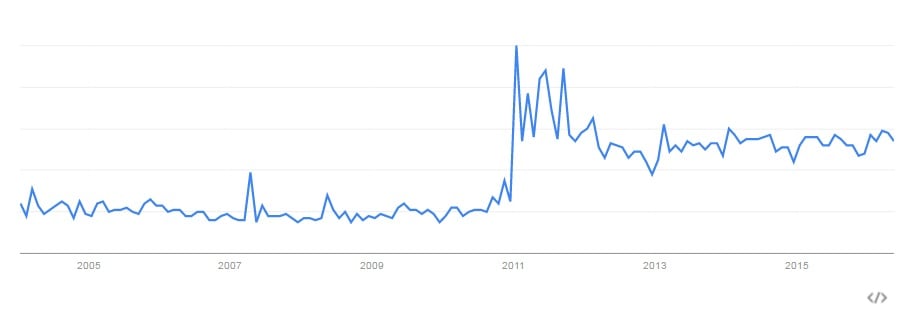Astaxanthin, an antioxidant carotenoid found in some fish and shellfish species, is commercially produced via the cultivation of the marine algae species Haematococcus pluvialis. The ingredient’s popularity spiked in the US following a 2011 appearance by health products promoter Dr Joseph Mercola on the Dr Oz Show. Mercola’s segment, titled “The No. 1 Supplement You’ve Never Heard Of” boosted the popularity of the ingredient tenfold. But unlike some other ingredients that have benefited from the ‘Dr Oz Effect’ such as raspberry keytones or green coffee bean extract, astaxanthin’s popularity has endured. With those other two, after being popularized on the show, interest in those ingredients as measured by the number of Google searches using the ingredient names as the search term spiked dramatically, then fell off just as dramatically. The number of searches conducted with ‘astaxanthin’ in the search field rose just as precipitously, but since then has held more or less steady at a greatly enhanced level.
Prof Yuval Heled, chief scientist at the Heller Institute of Medical Research in Jerusalem, spoke with NutraIngredients-USA about why he believes the ingredient has legs in the market. Heled was recently named chief science advisor of Algatechnologies, an Israel-based astaxanthin supplier, and he also and holds senior scientific positions at various universities, including Tel Aviv University, the Hebrew University in Jerusalem, and the Uniformed Services University of the Health Sciences in Bethesda, MD.

Inflammatory response
While the term inflammation is something of a bogeyman when making health claims on a dietary ingredient in the US market, Heled said there’s no getting away from the process when discussing health. Astaxanthin’s antioxidant bona fides are real, he said, and they are showing real benefits in supporting consumers’ everyday health needs and in benefiting athletic performance (his specialty).
“Chronic diseases of aging, lifestyle diseases like obesity and diabetes and extreme performance all have very similar mechanisms that are associated with inflammation and oxidative stress,” Heled said.
Heled said that stress on the system is one of the interesting underlying concepts behind astaxanthin research. Many bioactive molecules derived from botanicals arise as a result of those organisms’ response to environmental stressors, such as heat, drought, freezing or microbial or insect attack. In that way, astaxanthin is no different, Heled said, as the carotenoid is produced in the algal cell well as the microorganisms enter a cyst-like state in response to environmental stress.
“Astaxanthin is produced by stressing the algae with heat and starvation. The rationale here is by using astaxanthin, which is produced as a response to stress, we can use something that was created by nature for that purpose and apply it to cellular injury in the body,” Heled said.
Sports stress

Heled’s specialty is in researching the body’s reaction to extreme sports performance stress. It is a fruitful area of research, not only because of the great interest from dietary supplement companies because of the flourishing nature of the sports nutrition market, but also because extreme performance scenarios are a way to look at the body under stress without using a diseased population. Those kind of disease endpoints make linking the results of research to marketing claims on dietary supplements difficult if not impossible.
“One of my specialties in thermoregulation and heat injury. Astaxanthin has shown possibly to be protective of injury from heat stress in an animal model,” he said.
“My goal for the next few years is to concentrate on heat stress, and on muscle breakdown. We found in a preliminary mouse study that astaxanthin might have a prophylactic effect on muscle injuries. There is even some preliminary data that suggests astaxanthin could have a prophylactic effect on traumatic brain injury as well,” he said.
Unique structure
Heled said that astaxanthin’s unique molecular structure is a key part of the story of the ingredient’s effects in the body. Rather than circulating in the blood, acting a free radical sponge, something other antioxidants might claim as a mode of action, astaxanthin is incorporated into the cell wall and serves to better potentiate the cell’s natural antioxidant capacities by in part boosting the retained levels of glutathione, called the cell’s ‘master antioxidant.’
“Astaxanthin’s unique molecular structure helps protect the whole membrane. I don’t like to talk about overall reduction of oxidative stress. Free radicals are not necessarily bad for us. I like to talk about regulating oxidative stress,” Heled said.
Following the data
Heled said his research into astaxanthin is supported by Algatech to the extent of suppling free material, but that the company did not pay for his studies. He said he’s comfortable working with the company in an advisory capacity because he believes its management intends to do the right thing, and to follow skeins of research that really pan out in terms of support from the data rather than trying to shoehorn studies into a preconceived marketing plan.
“There are so many ingredients out there with so many claims. My goal is to try to assist them to create a good product. We scientists should assist companies in achieving a better scientific background for their products. We should be able to say, that result is not significant; I think you should go in this direction instead,” he said.
